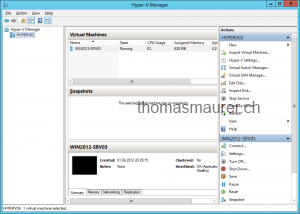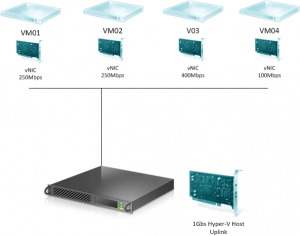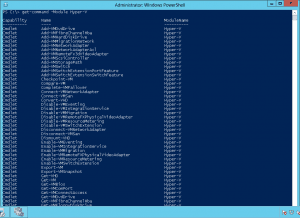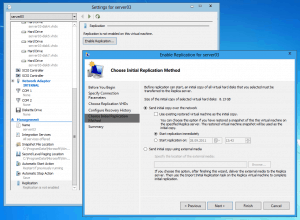Okay I admit it, the title is more a reference to a song than a true fact, because my first contact with the latest Hyper-V release was last September.
Last September Microsoft showed the newest release of Hyper-V at the build conference. Back then I wrote a blog post about the new version of Microsoft Hypervisor Hyper-V called “Hyper-V: Version 3 kills them all“.
Now Microsoft released the Windows Server 2012 and Microsoft Hyper-V 2012 Release Candidate last week. They made a lot of changes since September 2011 and I tried to show this in another blog post (What’s new in Windows Server 2012 Release Candidate Hyper-V: Scale). With these changes I decided to upgrade my blog post from September 2011 with the latest changes made with Windows Server 2012 Release Candidate.
Windows Server 2012 the Cloud OS
First let’s start with Windows Server 2012 as the base of Microsoft cloud strategy. Windows Server 2012 is probably the most significant release of the Windows Server platform ever. Microsoft’s focus in Windows Server 2012 was to make it easy for all to build public, private or hybrid cloud solutions. Microsoft has used the experience and learning from their own Cloud services like Hotmail, Messenger, Office 365, Bing, Windows Azure, and Xbox Live. There are a lot of improvements to manageability, security, scalability, extensibility, predictability and reliability which will also improve the possibilities with Hyper-V. The Power of Many, The Simplicity of One – In technical terms Microsoft made a lot of improvements how you can manage a lot of servers and services, Storage, Networking and PowerShell. Of course there is a lot more, but this are the parts I think are the most important. And here are some keywords to the improvements in Windows Server 2012:
- Storage improvements – SMB 3.0, SMB transparent Failover, data de-duplication, Storage Spaces, online filesystem repairs, 64TB NTFS volumes, ReFS volumes, etc.
- NIC Teaming
- NIC Naming and CDN (consistent device naming)
- PowerShell v3 – You can now just do everything in PowerShell and even more with 23000 PowerShell cmdlets.
- Server Dashboard – The new Dashboard lets you manage all servers, or even better, all Services from one place.
- Multi-tenant – everything seems to be made for that
- Performance Counters
- IP address management (IPAM)
Hyper-V Host improvements
The Hyper-V Host gets a lot of improvements in terms of features and scale.
- up to 320 logical CPUs
- supports up to 4 TB RAM
- no more vCPU:pCPU ration limit
- up to 2048 Virtual CPUs per Virtual Machine
Hyper-V Virtual Machine improvements
Microsoft did a lot to extend the existing Virtual Machine hardware to support even high workload Virtual Machines. Most of the time you were talking with VMware consultants, they tried to say that Hyper-V is not made for Enterprise workloads. Now with the release of Hyper-V 2012 scale should not be an argument anymore.
- New Virtual Disk format: VHDX – supports up to 64 TB Virtual Disks
- 64 Virtual CPUs per VM
- Up to 1 TB RAM per VM
- Support for Virtual Fibre Channel Adapters inside the Virtual Machine
- Virtual Guest NUMA support
- Dynamic Memory Improvements
- Smart Paging
- Supporting Virtual Active Directory Servers
Hyper-V Networking improvements
Hyper-V got a lot of improvements in terms of networking. Microsoft realized that networking features are really important if you start to create private and public cloud scenarios and now even create a mix of public and private cloud scenarios without creating a lot of work for the IT teams to reconfigure Virtual Machines.
- QoS and flexible bandwidth allocation
- Single-root I/O virtualization or SR-IOV (Direct Access to the physical Network adapter)
- Network Virtualization
- PVLAN support
- Dynamic Virtual Machine Queue (D-VMQ)
- Receive Side Coalescing (RSC)
- DHCP Guard
- Router Guard
- Port mirroring
- Port ACLs
- Trunk mode Allows directing traffic from a group of VLANs to a specific VM
- IPsec Task offload
- Integrated Network Adapter Teaming
- Better Network Adapter Naming and Consistent Network Device Naming
- Hyper-V Extensible Switch (for example Cisco Nexus 1000v)
- Data Center Bridging (DCB) – eliminates loss due to queue overflow and to be able to allocate bandwidth on links
- Network Metering
Hyper-V Clustering improvements
Hyper-V gets also a lot of Cluster improvements. Microsoft is working on Cloud solutions which will give great availability to low cost. For example Hyper-V Replica or Shared-Nothing Live Migration, which allows you to move a Virtual Machine from one Hyper-V host to another host over the Ethernet without the need for a shared storage or a Cluster.
- supporting up to 4000 VMs per cluster
- supporting up to 64 Cluster nodes
- improved Cluster Manager Console
- Application Monitoring – Application health detection inside the virtual machine
- New Placement policies – Virtual Machine Priority and enhanced placement
- Storage Live Migration
- VM Failover Prioritization
- Cluster Wide Task Scheduling
- Hyper-V Replica supporting clustering – replicate a Virtual Machine from one Cluster to another Cluster or Standalone Hyper-V Host
- No need for Block Storage – you can use SMB Shares
- Support for Storage Spaces
- Automated Node Draining – like Maintenance mode in SCVMM
- Cluster Aware Updating (CAU)
- Cluster Shared Volume Improvements – BitLocker support, a lot of performance improvements, Self-Healing
- CSV Block Cache
- CSV 2.0 (No Redirected I/O for Backup
- CSV 2.0 Block Level I/O redirection
- CSV enabled volumes now appear as “CSVFS”
- No Active Directory dependencies
- Live Migration Queuing
- Migrate multiple Virtual Machine at the same time
- Anti-Affinity VM Rules
- Dynamic Quorum
- Guest Clustering via ISCSI, SMB or Fibre Channel
Hyper-V Storage improvements
A I mentioned earlier Microsoft made a lot of improvements in terms of storage in Windows Server 2012 and Hyper-V can take advantage of those which are quiet impressive. For example with the new features in SMB 3.0 you can now use SMB file shares to store your Virtual Machines.
- New Virtual Disk format (VHDX supports up to 64 TB Virtual Disks)
- Offloaded Data Transfer – ODX (Open Diagnostic Data Exchange)
- Live merging of VHDs and Snapshots
- RDMA
- SMB 3.0 – Transparent Failover
- SMB 3.0 Direct
- SMB 3.0 Multichannel
- Native 4 KB sector disks support
- Data De-duplication
- Virtual Fibre Channel inside the Virtual Machines
- VM boot from SAN
- Storage Spaces (Pool Disks or LUNs)
- New File system ReFS
Hyper-V Management Improvements
As everywhere in Windows Server 2012 PowerShell is the key. And the new Server Manager Dashboard Microsoft enables to create Server Groups to manage multiple servers from a single console.
- PowerShell cmdlets for Hyper-V
- PowerShell Workflows – commands and tasks across servers
- Hyper-V Extensible Switch – lets vendors to create “plugins”.
- Server Manager Dashboard – lets you manage multiple Hyper-V hosts from a single console.
- System Center Virtual Machine Manager 2012 SP1 – not a part of Windows Server 2012 but will add great management solutions.
- Improved VM Import
- Local Hyper-V Administrator Group
- Client Hyper-V
Hyper-V Live Migration and Disaster Recovery
Now I think this is maybe the greatest new feature. You can migrate Virtual Machines from one Hyper-V Host to another without Shared Storage or Cluster configuration. This feature is called Shared-Nothing Live Migration. Microsoft also included a new feature called Hyper-V Replica which includes the option to replicate Virtual Machine to another host which can be hosted in the same datacenter, secondary datacenter or even in the cloud.
- Improved Live Migration
- Unlimited Simultaneous live migrations
- Live Storage Migration
- Shared-Nothing Live Migration – Live Migration to another Hosts (Not clustered) over Ethernet
- Hyper-V Replica – Replicated Virtual Machines to another Hyper-V host on-premise or public cloud over LAN or WAN connections.
The Windows Server Team and especially the Hyper-V Team did a great job, and I am sure Hyper-V will gain significant market share in the future.
Tags: Cluster, Hyper-V, Hyper-V 2012, Hyper-V Cluster, Hyper-V Replica, Hyper-V Server 2012, Live Migration, Microsoft, Microsoft Hyper-v, Scale, VHDX, Windows, Windows 8, Windows Server, Windows Server 2012 Last modified: January 7, 2019

















Is it possible to natively boot from a VHDx that is stored on a ReFS partition? (The VHDx is partitioned as NTFS, but the VHDx file itself is on a ReFS partition)
I don’t know atm ;-) Have to try.
But you cannot boot from a ReFS partition at the moment. Now I don’t know what exactly happens when you boot a NTFS VHD